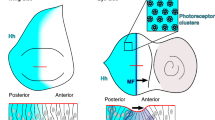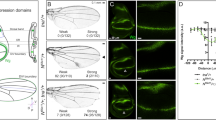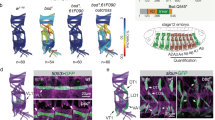Abstract
CELL patterning in the body segments of the Drosophila embryo requires activity of the segment polarity genes, a molecularly heterogeneous group defined by a generic mutant phenotype1. Two of these genes, wingless (wg) and hedgehog (hh), encode proteins that enter the secretory pathway2–4, implicating them as signals that instruct the fates of neighbouring cells5. Genetic analysis has identified wg transcription as one of the targets of hh activity6,7 and it has been suggested that the spatial control of wg expression depends on the limited range of the hh signal and the differential competence of responding cells8.I have tested this model by driving ubiquitous expression of the hh gene using the HspTO promoter. Here I report that, as predicted, this causes the ectopic activation of wg in only a subset of the cells of each parasegment. Using another target of hh activity as a probe, I demonstrate that the competence of cells to express wg is independent of their ability to receive the hh signal. Finally, I show that wg activation requires the function of the segment polarity gene fused, suggesting that the putative hh signal is transduced by the serine/threonine kinase that fused encodes.
This is a preview of subscription content, access via your institution
Access options
Subscribe to this journal
Receive 51 print issues and online access
$199.00 per year
only $3.90 per issue
Buy this article
- Purchase on Springer Link
- Instant access to full article PDF
Prices may be subject to local taxes which are calculated during checkout
Similar content being viewed by others
References
Nüsslein-Volhard, C. & Wieschaus, E. Nature 287, 795–801 (1980).
van den Heuvel, M., Nusse, R., Johnston, P. & Lawrence, P. A. Cell 59, 739–749 (1989).
Gonzalez, F., Swales, L., Bejsovec, A., Skaer, H. & Martinez-Arías, A. Mech. Dev. 35, 43–54 (1991).
Lee, J. J., von Kessler, D. P., Parks, S. & Beachy, P. A. Cell 71, 33–50 (1992).
Ingham, P. W. & Martinez-Arías, A. Cell 68, 221–235 (1992).
Hidalgo, A. & Ingham, P. Development 110, 291–301 (1990).
Ingham, P. W. & Hidalgo, A. Development 117, 283–291 (1993).
Ingham, P. W., Taylor, A. M. & Nakano, Y. Nature 353, 184–187 (1991).
Martinez-Arías, A. & Lawrence, P. A. Nature 313, 639–642 (1985).
Baker, N. E. EMBO J. 6, 1765–1773 (1987).
Mohler, J. & Vani, K. Development 115, 957–971 (1992).
Tabata, T., Eaton, S. & Kornberg, T. B. Genes Dev. 6, 2635–2645 (1992).
Tashiro, S. et al. Gene 124, 183–189 (1993).
Rijsewijk, F. et al. Cell 50, 649–657 (1987).
Taylor, A. M., Nakano, Y., Mohler, J. & Ingham, P. W. Mech. Dev. 43, 89–96 (1993).
Hooper, J. & Scott, M. P. Cell 59, 751–765 (1989).
Nakano, Y. et al. Nature 341, 508–513 (1989).
Martinez-Arías, A., Baker, N. & Ingham, P. W. Development 103, 157–170 (1988).
Martinez-Arías, A., J. Embryol. exp. Morph. 87, 99–114 (1985).
Preat, T. et al. Nature 347, 87–89 (1990).
Limbourg-Bouchon, B., Busson, D. & Lamour-Isnard, C. Development 112, 417–429 (1991).
DiNardo, S., Sher, E., Heemskerk-Jongens, J., Kassis, J. & O'Farrell, P. H. Nature 332, 604–609 (1988).
Noordermeer, J., Johnston, P., Rijsewijk, F., Nusse, R. & Lawrence, P. A. Development 116, 711–719 (1992).
Dougan, S. & DiNardo, S. Nature 360, 347–350 (1992).
Bejsovec, A. & Martinez-Arías, M. Development 113, 471–485 (1991).
Thummel, C. S., Boulet, A. M. & Lipshitz, H. D. Gene 74, 445–456 (1988).
Roberts, D. B. in Drosophila: a Practical Approach (ed. Roberts, D. B.) 1–38 (IRL, Oxford, 1986).
DiNardo, S., Kuner, J. M., Theis, J. & O'Farrell, P. J. Cell 43, 59–69 (1985).
Author information
Authors and Affiliations
Rights and permissions
About this article
Cite this article
Ingham, P. Localized hedgehog activity controls spatial limits of wingless transcription in the Drosophila embryo. Nature 366, 560–562 (1993). https://doi.org/10.1038/366560a0
Received:
Accepted:
Issue Date:
DOI: https://doi.org/10.1038/366560a0
This article is cited by
-
Disruption of Dhcr7 and Insig1/2 in cholesterol metabolism causes defects in bone formation and homeostasis through primary cilium formation
Bone Research (2020)
-
The Hedgehog signalling pathway in bone formation
International Journal of Oral Science (2015)
-
Travelling and splitting of a wave of hedgehog expression involved in spider-head segmentation
Nature Communications (2011)
-
Mechanisms and functions of Hedgehog signalling across the metazoa
Nature Reviews Genetics (2011)
-
Orchestrating ontogenesis: variations on a theme by sonic hedgehog
Nature Reviews Genetics (2006)
Comments
By submitting a comment you agree to abide by our Terms and Community Guidelines. If you find something abusive or that does not comply with our terms or guidelines please flag it as inappropriate.



